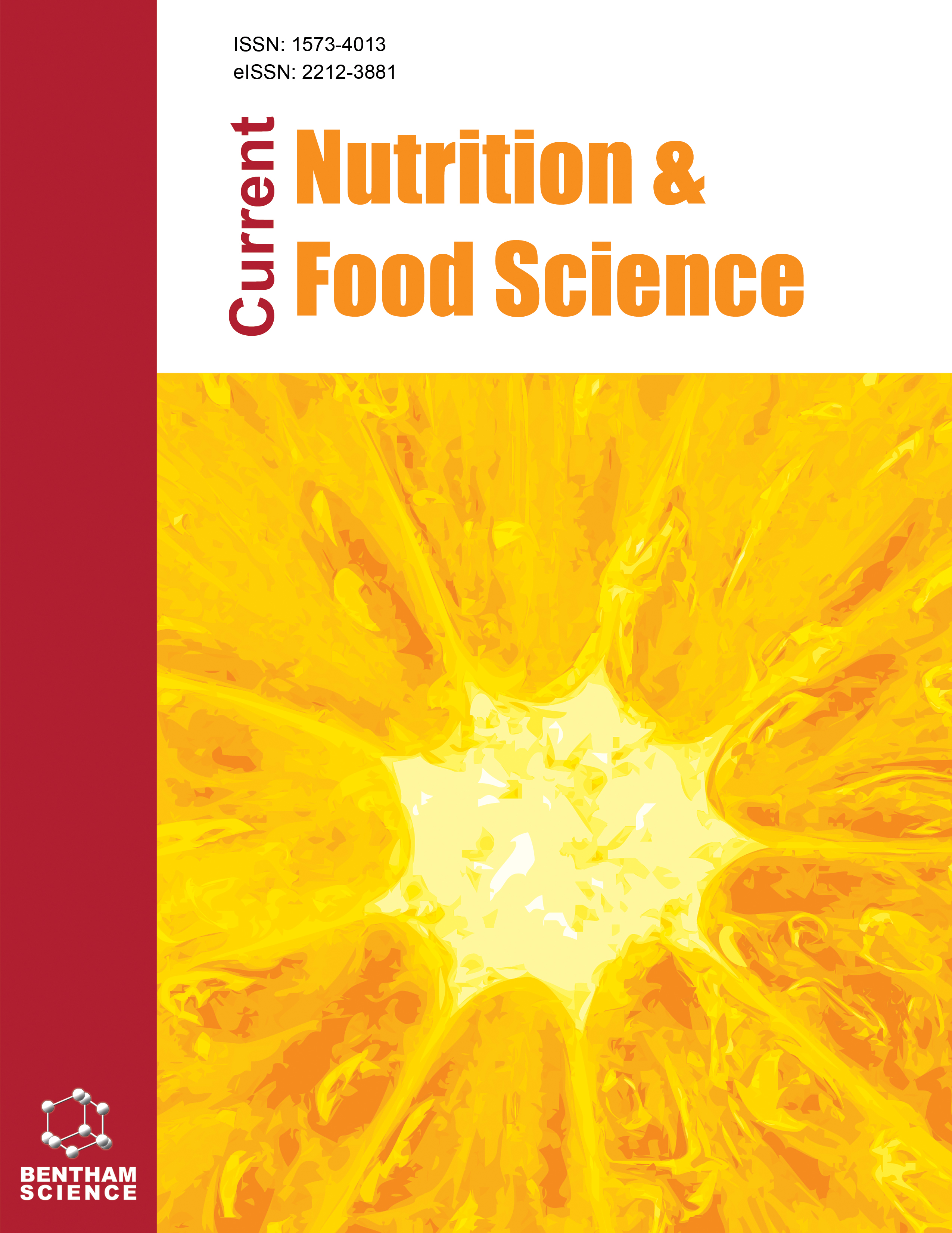- Home
- A-Z Publications
- Current Nutrition & Food Science
- Previous Issues
- Volume 2, Issue 4, 2006
Current Nutrition & Food Science - Volume 2, Issue 4, 2006
Volume 2, Issue 4, 2006
-
-
Vitamin D: Status, Supplementation and Immunomodulation
More LessAuthors: Maria S. Barnes, Paula J. Robson, Maxine P. Bonham, J. J. Strain and Julie M.W. WallaceNumerous studies have shown suboptimal vitamin D status in populations at high geographical latitudes, owing to a reduced capacity to synthesise vitamin D, especially during wintertime. Vitamin D supplementation has been shown to be effective at maintaining adequate vitamin D status throughout the year in these countries. Classically reported to play a central role in bone health, vitamin D has more recently been show Read More
-
-
-
Mediterranean Diet and Longevity
More LessAuthors: Danit R. Shahar and Itamar GrottoDiet and lifestyle influence morbidity and mortality. Among the elderly it is of particular importance to adopt diet and lifestyle practices that minimize their risk of morbidity and maximize their prospects for healthful aging. The Mediterranean diet is a model of a healthy diet that represents the dietary pattern among populations of the Mediterranean area. Most studies that were published in the last decade evalu Read More
-
-
-
Cyclodextrins as Food Additives and in Food Processing
More LessAuthors: Giancarlo Cravotto, Arianna Binello, Enzo Baranelli, Paolo Carraro and Francesco TrottaThis review deals with the applications of cyclodextrins (CDs) to food manufacture, focusing on the technical advantages of their use in food processing and as food additives. Their beneficial effects essentially derive from the ability to form stable inclusion complexes with sensitive lipophilic nutrients and constituents of flavor and taste. Toxicological data are examined and an assessment of CDs from the standpoint Read More
-
-
-
Dietary Fat Intake and Allergic Diseases
More LessAuthors: Stefanie Sausenthaler, Berthold Koletzko and Joachim HeinrichDietary factors, in particular dietary fat intake, are discussed as potential determinants for the development of allergic diseases. However, studies analyzing the relationship between dietary fat intake and allergic outcomes reported inconsistent and even conflicting findings. Therefore, this strategic review summarizes the findings from observational studies estimating the association of dietary fat intake with allergic disease Read More
-
-
-
The Vicious Circle of Leptin and Obesity
More LessThe discovery of leptin in 1994 revolutionized our knowledge of the role of adipose tissue in nutrition. This hormone is synthesized in adipocytes, and the cell membrane of most cells bears leptin receptors, but it exerts its action mainly in the hypothalamus by inhibiting the production of neuropeptide Y and diminishing appetite. Free and bound leptin is present in plasma, where it has a soluble receptor: sOb-R. The proport Read More
-
-
-
Propionate: Hypophagic Effects Observed in Animal Models Might be Transposed to the Human Obesity Management
More LessAuthors: Jean-Philippe Chaput, M. Carole Thivierge and Angelo TremblayVolatile fatty acids (VFA) are the main energy source for ruminants, generally accounting for 50-75% of energy digested. They are produced from microbial fermentation of food in the rumen and are known to control food intake. Propionic acid, which is a major VFA produced in the rumen, is responsible of a feeding-induced behavior regulation in ruminants and its absorption results in a down-regulated energy intake in these Read More
-
-
-
Taurine and the Relevance of Supplementation in Humans, in Health and Disease
More LessTaurine, a beta-sulphur amino acid with a zwitterionic function, plays an important role in several biological processes. In humans taurine synthesis is limited. Therefore, intake by food is important. A normal diet, including animal products, contains a sufficient amount of taurine to provide the physiological necessary quantity of taurine. Taurine is a component of bile salts, which function as detergents for emulsification of dietar Read More
-
-
-
Nutritional Programming of Foetal Development: Endocrine Mediators and Long-Term Outcomes for Cardiovascular Health
More LessAuthors: Michael E. Symonds, Helen Budge, Alison Mostyn, Terence Stephenson and David S. GardnerEpidemiological studies on historical and contemporary populations indicate that the uterine environment is a major factor contributing to later health and disease in the resulting offspring. These findings are supported by experimental studies which indicate that both macro and micronutrient deficiencies have long-term health implications for the offspring. Maternal nutrition directly determines foetal and placent Read More
-
-
-
Impact of Nutrients on the Functioning of Intestinal Goblet Cells: Health and Therapeutic Perspectives
More LessSecreted by goblet cells, intestinal mucins play a crucial role in cytoprotective functions against mechanical insults, colonisation by pathogenic bacteria and their toxins, luminal proteases and potential carcinogens. The present paper provides a review of the effect of nutrients on intestinal mucin secretion. In the small intestine, the secretion of mucus is modulated by hydrolysates of milk proteins and by β-casomorphins (a f Read More
-
-
-
Use of Iron as a Fortificant in Whole-Wheat Flour and Leavened Flat Bread in Developing Countries
More LessAuthors: Faqir Muhammad Anjum, Adnan Zulfiqar, Ali Asghar and Shahzad HussainAmong various nutritional strategies to combat iron deficiency, fortification of food is generally considered to be the best and cost effective long-term strategy. Iron is a key micronutrient and an integral part of haemoglobin, required for the transport of oxygen and carbon dioxide in blood. Among the cereals, which the ability of being successfully fortified with iron, wheat has additional advantage to be used as a vehicle. Th Read More
-
Volumes & issues
-
Volume 21 (2025)
-
Volume 20 (2024)
-
Volume 19 (2023)
-
Volume 18 (2022)
-
Volume 17 (2021)
-
Volume 16 (2020)
-
Volume 15 (2019)
-
Volume 14 (2018)
-
Volume 13 (2017)
-
Volume 12 (2016)
-
Volume 11 (2015)
-
Volume 10 (2014)
-
Volume 9 (2013)
-
Volume 8 (2012)
-
Volume 7 (2011)
-
Volume 6 (2010)
-
Volume 5 (2009)
-
Volume 4 (2008)
-
Volume 3 (2007)
-
Volume 2 (2006)
-
Volume 1 (2005)
Most Read This Month
Article
content/journals/cnf
Journal
10
5
false
en


